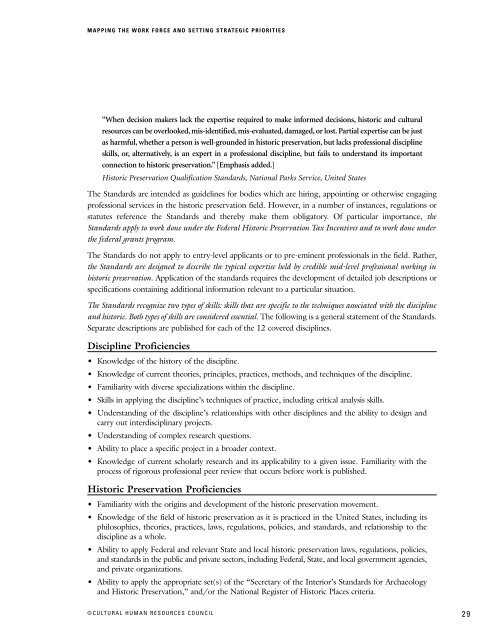Human Resources in Canada's Built Heritage Sector: Mapping the ...
Human Resources in Canada's Built Heritage Sector: Mapping the ...
Human Resources in Canada's Built Heritage Sector: Mapping the ...
- No tags were found...
Create successful ePaper yourself
Turn your PDF publications into a flip-book with our unique Google optimized e-Paper software.
MAPPING THE WORK FORCE AND SETTING STRATEGIC PRIORITIES“When decision makers lack <strong>the</strong> expertise required to make <strong>in</strong>formed decisions, historic and culturalresources can be overlooked, mis-identified, mis-evaluated, damaged, or lost. Partial expertise can be justas harmful, whe<strong>the</strong>r a person is well-grounded <strong>in</strong> historic preservation, but lacks professional discipl<strong>in</strong>eskills, or, alternatively, is an expert <strong>in</strong> a professional discipl<strong>in</strong>e, but fails to understand its importantconnection to historic preservation.” [Emphasis added.]Historic Preservation Qualification Standards, National Parks Service, United StatesThe Standards are <strong>in</strong>tended as guidel<strong>in</strong>es for bodies which are hir<strong>in</strong>g, appo<strong>in</strong>t<strong>in</strong>g or o<strong>the</strong>rwise engag<strong>in</strong>gprofessional services <strong>in</strong> <strong>the</strong> historic preservation field. However, <strong>in</strong> a number of <strong>in</strong>stances, regulations orstatutes reference <strong>the</strong> Standards and <strong>the</strong>reby make <strong>the</strong>m obligatory. Of particular importance, <strong>the</strong>Standards apply to work done under <strong>the</strong> Federal Historic Preservation Tax Incentives and to work done under<strong>the</strong> federal grants program.The Standards do not apply to entry-level applicants or to pre-em<strong>in</strong>ent professionals <strong>in</strong> <strong>the</strong> field. Ra<strong>the</strong>r,<strong>the</strong> Standards are designed to describe <strong>the</strong> typical expertise held by credible mid-level professional work<strong>in</strong>g <strong>in</strong>historic preservation. Application of <strong>the</strong> standards requires <strong>the</strong> development of detailed job descriptions orspecifications conta<strong>in</strong><strong>in</strong>g additional <strong>in</strong>formation relevant to a particular situation.The Standards recognize two types of skills: skills that are specific to <strong>the</strong> techniques associated with <strong>the</strong> discipl<strong>in</strong>eand historic. Both types of skills are considered essential. The follow<strong>in</strong>g is a general statement of <strong>the</strong> Standards.Separate descriptions are published for each of <strong>the</strong> 12 covered discipl<strong>in</strong>es.Discipl<strong>in</strong>e Proficiencies• Knowledge of <strong>the</strong> history of <strong>the</strong> discipl<strong>in</strong>e.• Knowledge of current <strong>the</strong>ories, pr<strong>in</strong>ciples, practices, methods, and techniques of <strong>the</strong> discipl<strong>in</strong>e.• Familiarity with diverse specializations with<strong>in</strong> <strong>the</strong> discipl<strong>in</strong>e.• Skills <strong>in</strong> apply<strong>in</strong>g <strong>the</strong> discipl<strong>in</strong>e’s techniques of practice, <strong>in</strong>clud<strong>in</strong>g critical analysis skills.• Understand<strong>in</strong>g of <strong>the</strong> discipl<strong>in</strong>e’s relationships with o<strong>the</strong>r discipl<strong>in</strong>es and <strong>the</strong> ability to design andcarry out <strong>in</strong>terdiscipl<strong>in</strong>ary projects.• Understand<strong>in</strong>g of complex research questions.• Ability to place a specific project <strong>in</strong> a broader context.• Knowledge of current scholarly research and its applicability to a given issue. Familiarity with <strong>the</strong>process of rigorous professional peer review that occurs before work is published.Historic Preservation Proficiencies• Familiarity with <strong>the</strong> orig<strong>in</strong>s and development of <strong>the</strong> historic preservation movement.• Knowledge of <strong>the</strong> field of historic preservation as it is practiced <strong>in</strong> <strong>the</strong> United States, <strong>in</strong>clud<strong>in</strong>g itsphilosophies, <strong>the</strong>ories, practices, laws, regulations, policies, and standards, and relationship to <strong>the</strong>discipl<strong>in</strong>e as a whole.• Ability to apply Federal and relevant State and local historic preservation laws, regulations, policies,and standards <strong>in</strong> <strong>the</strong> public and private sectors, <strong>in</strong>clud<strong>in</strong>g Federal, State, and local government agencies,and private organizations.• Ability to apply <strong>the</strong> appropriate set(s) of <strong>the</strong> “Secretary of <strong>the</strong> Interior’s Standards for Archaeologyand Historic Preservation,” and/or <strong>the</strong> National Register of Historic Places criteria.©CULTURAL HUMAN RESOURCES COUNCIL29










